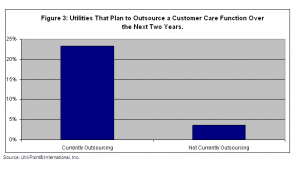May 2010 Vol. 237 No. 5
Features
Outsourcings Growth In The Utility Industry
In today’s business environment outsourcing has become relatively commonplace. It is a model utilized to lower costs, improve performance, and to create efficiencies. It touches most industries, and the utility sector is certainly no exception.
Every year UtiliPoint International, Inc. surveys more than 200 utilities in North America on customer service issues, including the topic of outsourcing. The resulting analysis and report marks the seventh annual survey of North American utilities by UtiliPoint and provides unique trending analysis when compared to the surveys of the previous years.
In our most recent survey we found that more than 72% of utilities have either outsourced a customer-care function (defined as billing, collections, remittance or contact center) or are planning to outsource a customer care function in the next two years. As Figure 1 demonstrates, the percentage of respondents that are outsourcing or planning to outsource rose dramatically from the survey’s inception in 2002. However, since 2005 the percentage of utilities that are outsourcing or planning to outsource has been declining or flat until the most recent survey which represents the first time since 2005 that the percentage has increased.
Facing a challenging and struggling economy, it is not surprising that many utilities would adopt cost-containment strategies that include a consideration of outsourcing what is not “core” to their business.
In the most recent survey respondents were also specifically asked about 12 separate outsourced functions. Bill printing, by far, was the most outsourced customer care function. Customer relationship management (CRM) systems was the least cited customer care functions, with less than 1% of the survey respondents indicating that they were outsourcing this function (Figure 2).

This was the sixth consecutive year that bill printing was cited as the leading customer care function being outsourced, with more than 47% of utilities indicating that this process was being outsourced.
While the percentage of utilities that outsource has grown significantly since last year, most of the individual functions being outsourced actually declined. That is to say that the percentage of utilities increased, but utilities are outsourcing fewer functions. This would suggest that utilities are becoming more selective in what they are willing to outsource.
Another interesting aspect of the outsourcing results pertains to where outsourcing growth will come from in the future. According to survey respondents, it will be coming predominantly from the utilities that are already outsourcing a customer care function. This would seem to suggest that utilities have been relatively happy with their current outsourcing arrangements.
More than 23% of utilities that have outsourced a customer care function plan to outsource another function in the next two years. Only less than 4% of utilities that have not already outsourced a customer care function plan to start outsourcing over the next two years (Figure 3).

These results imply that first-time outsourcers are often hesitant to entrust their customer service functions to another company. This apprehension can often be lessened when companies take a cautious approach and start by outsourcing lower-risk functions, such as collection calls and back-office systems and support.
So why are utilities that currently outsource so much more likely to outsource additional services in the future? As utilities continuously examine their business processes with the goal of cutting costs and focusing on core competencies, many have found that outsourcing allows them to reduce operating expenses, focus managerial attention on the aspects of their businesses that permit competitive differentiation, and access skills and capabilities not present in their organizations.
The survey results would suggest that the varied needs of utilities are being addressed by providers of outsourced services. The results also insinuate that outsourcing’s future growth could be slowing. This is the first time in the survey’s history that the percentage of utilities that plan to outsource a customer care function is less than 30%.
No matter what one’s opinion of outsourcing, I think everyone can agree that outsourcing is not a decision for everyone. Additionally, outsourcing alone is not going to miraculously save an ailing utility. However, it would appear that outsourcing can be a powerful force for positive change for some utilities, and UtiliPoint’s recent survey suggests that even the most traditional and conventional utility organizations benefit from it. Furthermore, the survey makes clear that the outsourcing utilities of tomorrow are the outsourcing utilities of today.
Acknowledgement
This article is courtesy of UtiliPoint International, Inc., Albuquerque, NM.
Author
J. Christopher Perdue is managing director at UtiliPoint International, Inc. He is a 19-year veteran of the energy and utility industries and leads UtiliPoint’s market research and smart grid practice areas. He can be reached at cperdue@ utilipoint.com.





Comments